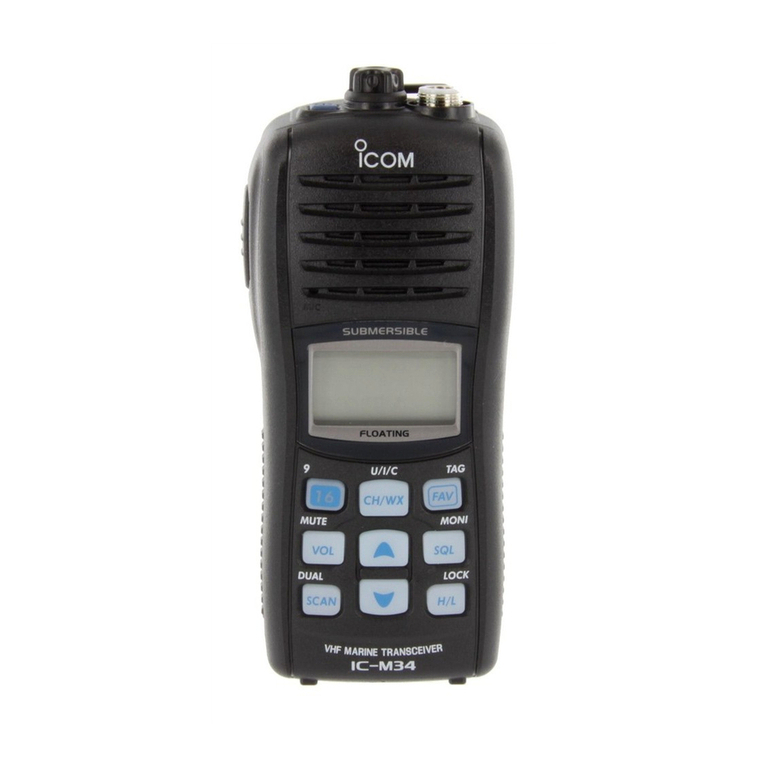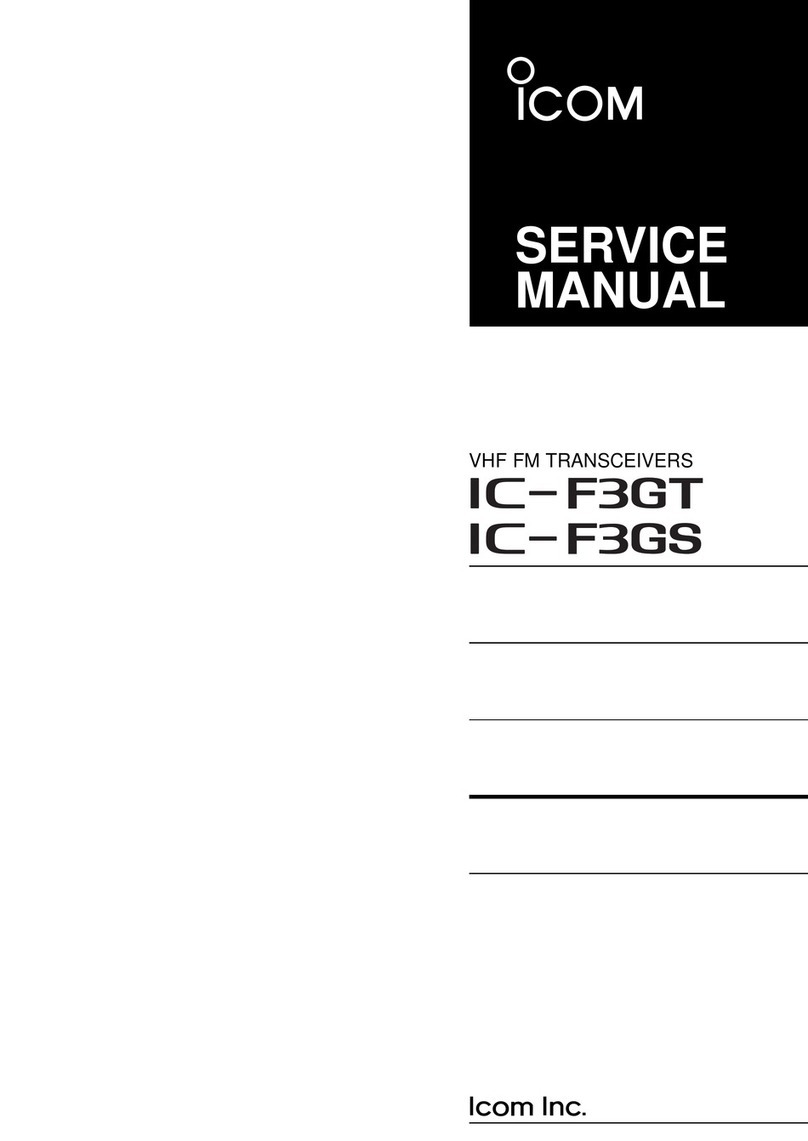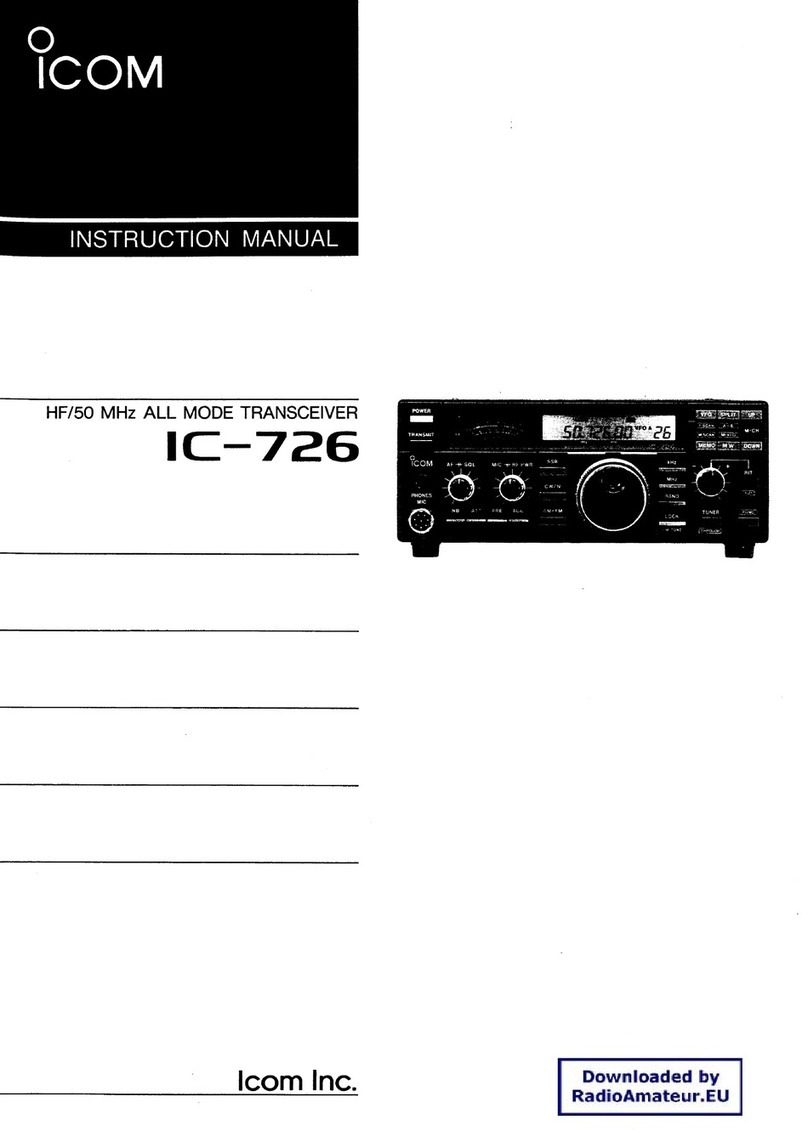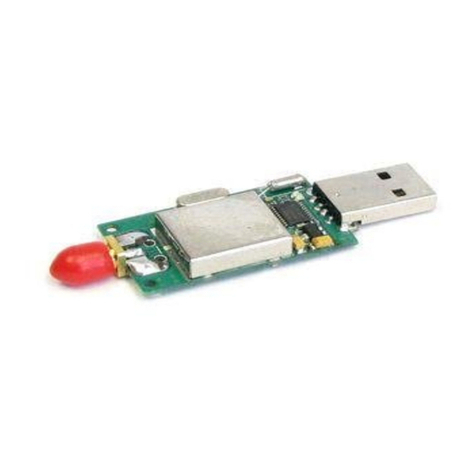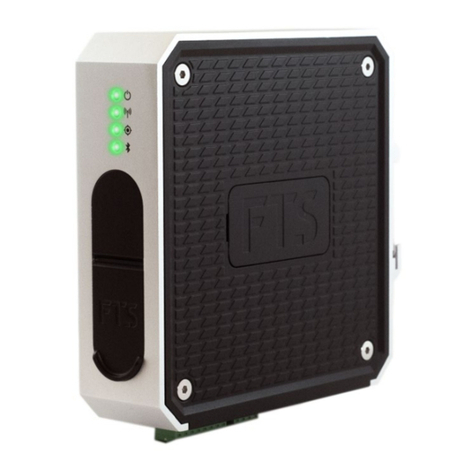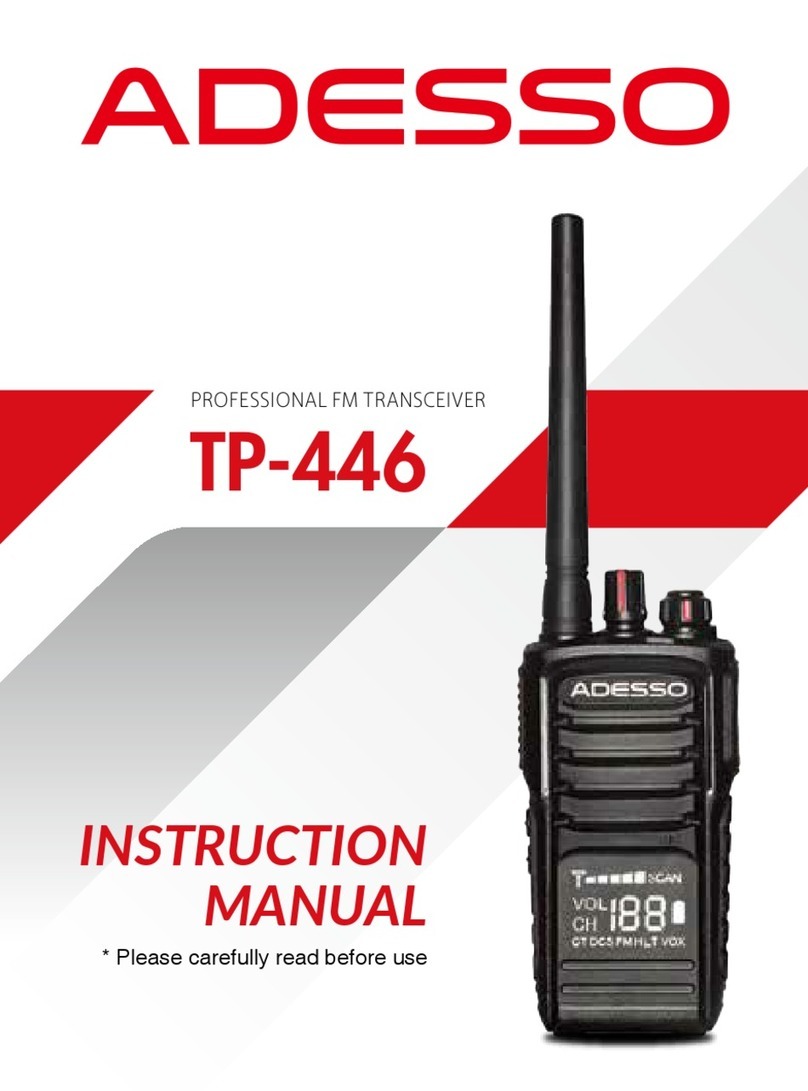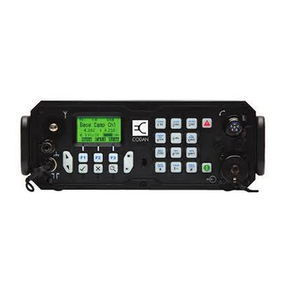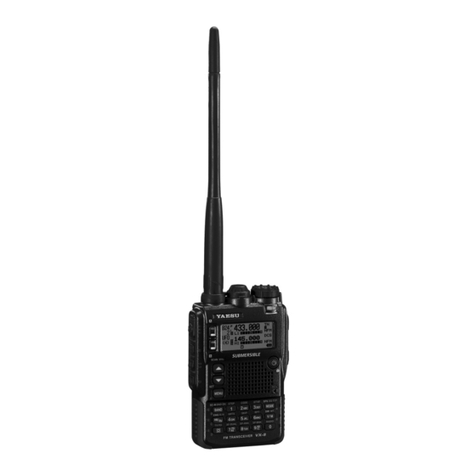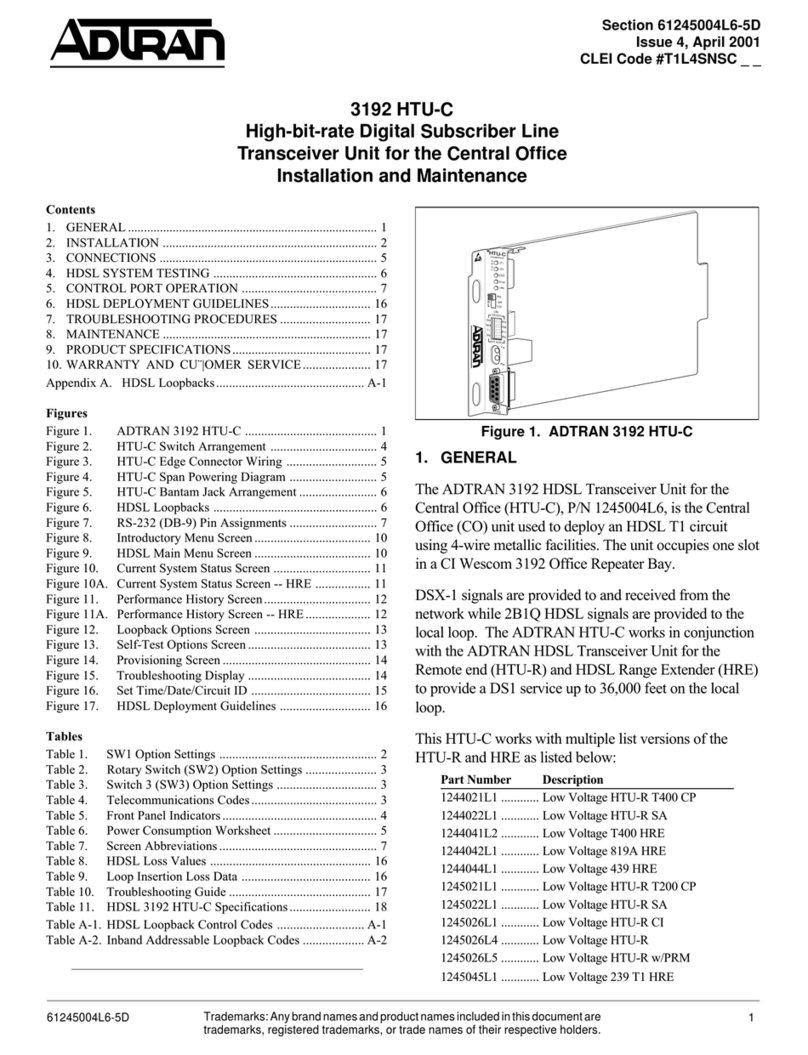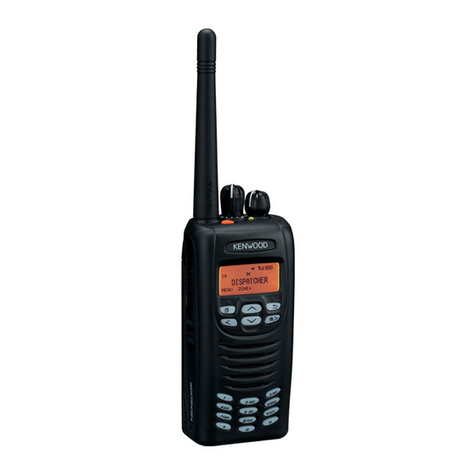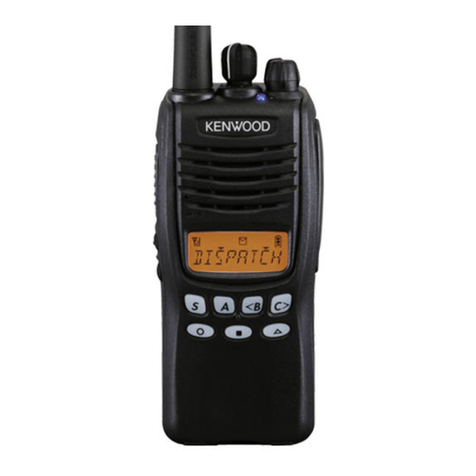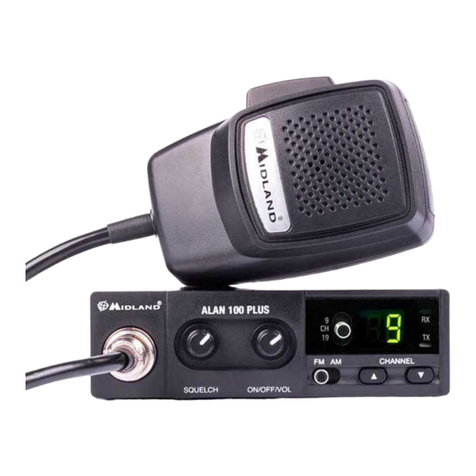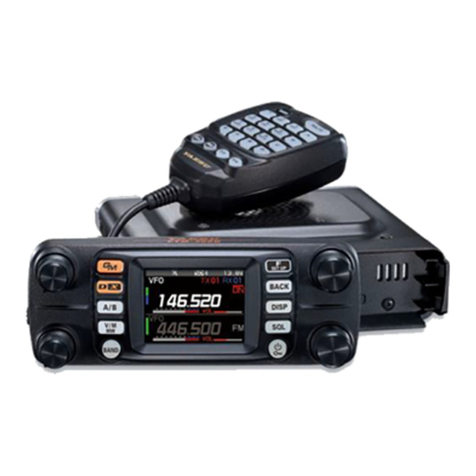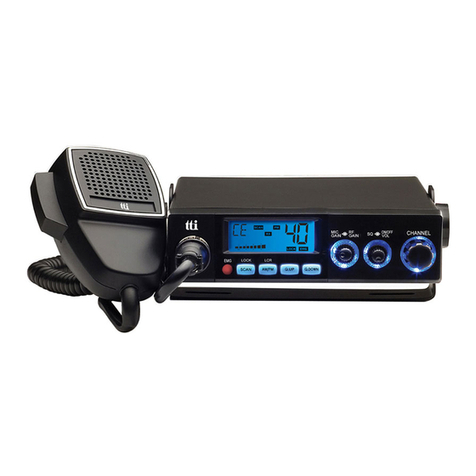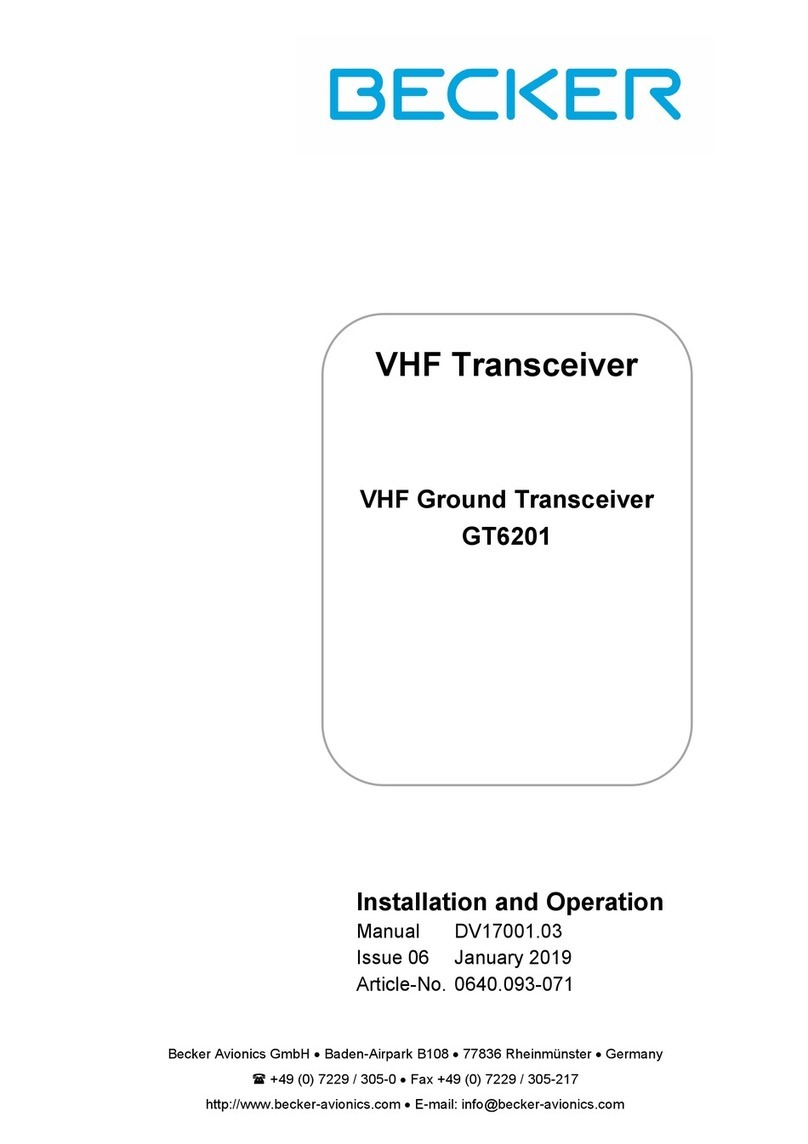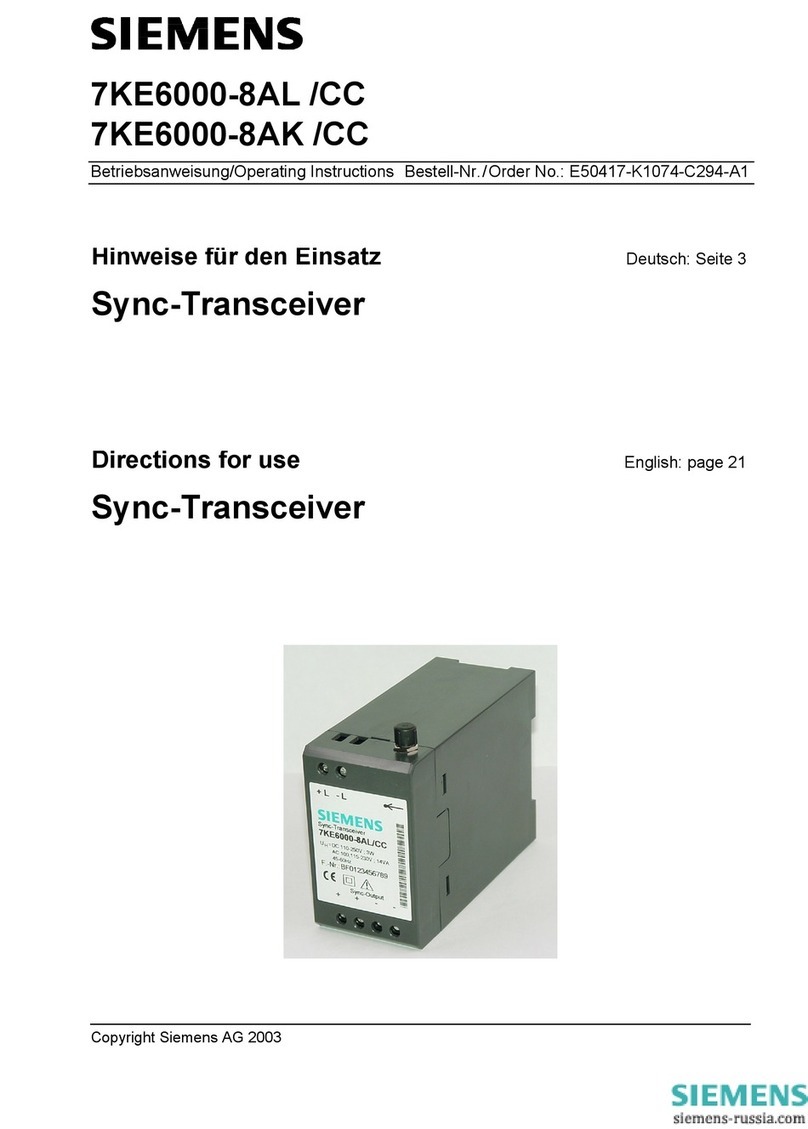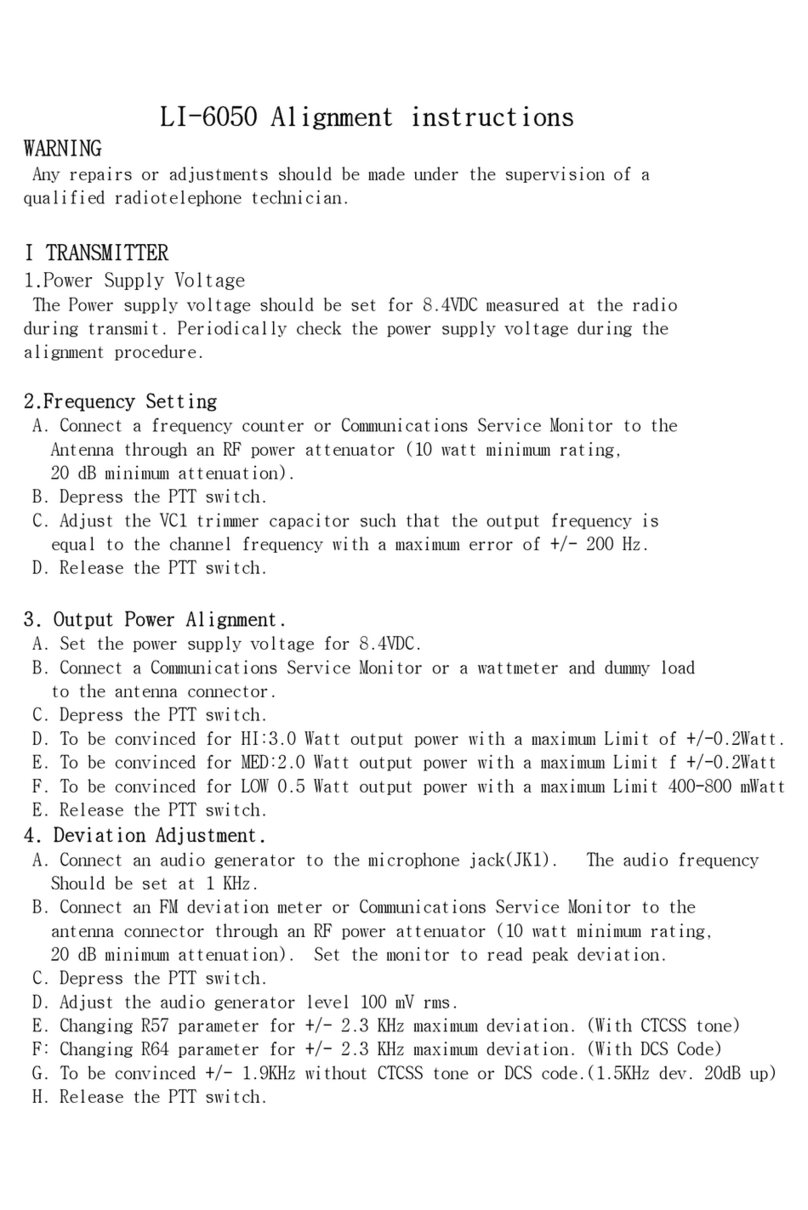Icom IF1721/D User manual

INSTRUCTION MANUAL
This device complies with Part 15 of the FCC Rules.
Operation is subject to the condition that this device
does not cause harmful interference.
UHF MOBILE TRANSCEIVER
iF2821/D
iF2721/D
Above photo shows the IC-F1721/D or IC-F2721/D.
VHF MOBILE TRANSCEIVER
iF1821/D
iF1721/D

i
IMPORTANT
READ ALL INSTRUCTIONS carefully and com-
pletely before using the transceiver.
SAVE THIS INSTRUCTION MANUAL — This
instruction manual contains important operating instruc-
tions for the IC-F1721, IC-F1721D, IC-F1821, IC-F1821D,
IC-F2721, IC-F2721D, IC-F2821 and IC-F2821D VHF/UHF
MOBILE TRANSCEIVERS.
See the operating guide for details of MDC 1200 system
operation. Consult with your Icom dealer or system opera-
tor for details concerning your transceiver’s programming.
Icom, Icom Inc. and the Icom logo are registered trademarks of Icom Incor-
porated (Japan) in Japan, the United States, the United Kingdom, Germany,
France, Spain, Russia and/or other countries.
All other products or brands are registered trademarks or trademarks of their
respective holders.
EXPLICIT DEFINITIONS
WORD DEFINITION
RWARNING! Personal injury, fire hazard or electric
shock may occur.
CAUTION Equipment damage may occur.
NOTE If disregarded, inconvenience only. No risk
of personal injury, fire or electric shock.
This instruction manual includes some functions which are
usable only when they are preprogrammed by your dealer.
Ask your dealer for details.

RWARNING! NEVER connect the transceiver to an
AC outlet. This may pose a fire hazard or result in an electric
shock.
RWARNING! NEVER place the transceiver where
normal operation of the vehicle may be hindered or where it
could cause bodily injury.
RWARNING! NEVER connect the transceiver to a
power source of more than 16 V DC such as a 24 V battery.
This connection will ruin the transceiver.
RWARNING! NEVER cut the DC power cable be-
tween the DC plug and fuse holder. If an incorrect connection
is made after cutting, the transceiver might be damaged.
CAUTION: NEVER allow children to touch the trans-
ceiver.
CAUTION: NEVER expose the transceiver to rain,
snow or any liquids.
USE the specified microphone only. Other microphones
have different pin assignments and may damage the trans-
ceiver.
DO NOT use or place the transceiver in areas with tem-
peratures below –30°C (–22°F) or above +60°C (+140°F), or
in areas subject to direct sunlight, such as the dashboard.
DO NOT operate the transceiver without running the ve-
hicle’s engine. The vehicle’s battery will quickly run out when
the transceiver transmits while the vehicle’s engine is OFF.
DO NOT place the transceiver in excessively dusty envi-
ronments.
DO NOT place the transceiver against walls. This will ob-
struct heat dissipation.
DO NOT use the chemical agents such as benzine or alco-
hol when cleaning, as they damage the transceiver surfaces.
BE CAREFUL! The transceiver will become hot when
operating continuously for long periods.
Approved Icom optional equipment is designed for optimal
performance when used with an Icom transceiver.
Icom is not responsible for the destruction or damage to an
Icom transceiver in the event the Icom transceiver is used with
equipment that is not manufactured or approved by Icom.
For U.S.A. only
CAUTION: Changes or modifications to this transceiver, not
expressly approved by Icom Inc., could void your authority to
operate this transceiver under FCC regulations.
PRECAUTIONS
ii

iii
ABOUT APCO PROJECT 25
This device made under license under one or more of the
following US patents: #4,590,473, #4,636,791, #5,148,482,
#5,185,796, #5,271,017, #5,377,229.
The IMBE™ voice coding Technology embodied in this prod-
uct is protected by intellectual property rights including patent
rights, copyrights and trade secrets of Digital Voice Systems,
Inc. This voice coding Technology is licensed solely for use
within this Communications Equipment. The user of this Tech-
nology is explicitly prohibited from attempting to decompile, re-
verse engineer, or disassemble the Object Code, or in any other
way convert the Object Code into a human-readable form. U.S.
Pat. Nos. #5,870,405, #5,826,222, #5,754,974, #5,701,390,
#5,715,365, #5,649,050, #5,630,011, #5,581,656, #5,517,511,
#5,491,772, #5,247,579, #5,226,084, #5,195,166.
FCC INFORMATION
• FOR CLASS A UNINTENTIONAL RADIATORS:
This equipment has been tested and found to comply with the
limits for a Class A digital device, pursuant to part 15 of the
FCC Rules. These limits are designed to provide reasonable
protection against harmful interference when the equipment
is operated in a commercial environment. This equipment
generates, uses, and can radiate radio frequency energy
and, if not installed and used in accordance with the instruc-
tion manual, may cause harmful interference to radio com-
munications.
Operation of this equipment in a residential area is likely to
cause harmful interference in which case the user will be re-
quired to correct the interference at his own expense.

iv
TABLE OF CONTENTS
IMPORTANT .......................................................................... i
EXPLICIT DEFINITIONS....................................................... i
PRECAUTIONS.................................................................... ii
ABOUT APCO PROJECT 25 .............................................. iii
FCC INFORMATION ........................................................... iii
TABLE OF CONTENTS....................................................... iv
1 PANEL DESCRIPTION................................................1–8
Front panel■...................................................................1
Function display■...........................................................2
Programmable function keys■........................................3
2 BASIC OPERATION..................................................9–14
Turning power ON■........................................................9
Channel selection■........................................................9
Call procedure■............................................................10
Receiving and transmitting■.........................................10
User Set mode■...........................................................14
Scrambler function■.....................................................14
3 BIIS OPERATION....................................................15–25
Default setting■............................................................15
Receiving a call■..........................................................15
Transmitting a call■......................................................17
Receiving a message■.................................................19
Transmitting a status■..................................................21
Transmitting an SDM (Short Data Message)■.............22
Position data transmission■.........................................24
Printer connection■......................................................24
Digital ANI■..................................................................24
Auto emergency transmission■....................................24
Stun function■..............................................................25
BIIS indication■............................................................25
Priority A channel selection■........................................25
Horn output■................................................................25
4 CONNECTION AND MAINTENANCE ....................26–30
Rear panel connection■...............................................26
Supplied Accessories■.................................................27
Mounting the transceiver■............................................28
Optional OPC-617 installation■....................................28
Optional UT-109 or UT-110installation■.......................29
Antenna■......................................................................30
Fuse replacement■......................................................30
Cleaning■.....................................................................30
Options■.......................................................................30
5 SAFETY TRAINING INFORMATION.......................31–34

1
1PANEL DESCRIPTION
Front panel■
Icom Inc
yoruti
qe*w
e*
IC-F1721/D
IC-F1821/D
F2721/D
F2821/D
qAF VOLUME CONTROL KNOB
Rotate the knob to adjust the audio output level.
•Minimumaudiolevelispre-programmed.
wFUNCTION DISPLAY (p. 2)
Displays a variety of information, such as an operating
channel number/name, 5-tone code, DTMF numbers and
audible condition, etc.
eDIAL or UP/DOWN KEYS
•IC-F1721/D,F2721/D:DIAL
Rotate to select an operating channel, etc.*
•IC-F1821/D,F2821/D:UP/DOWN Keys
Push to select an operating channel, etc.*
*The desired function can be assigned by your dealer. (p. 3)
r10-KEYPAD (IC-F1821/D or IC-F2821/D only)
The keypad allows you to enter digits to:
•Selectmemorychannels,tonechannelsandDTMFcodes(when
in the DTMF code channel selection mode)
•SetTXcodesandBIISstatusnumber
•InputtextmessageforSDMoperation
•Startupwithapassword
•InputtheIndividualIDcodefordigitaloperation.
tBUSY INDICATOR
Lights green while receiving a signal, or when the squelch
is open.

2
1
PANEL DESCRIPTION
1
2
3
4
5
6
7
8
9
10
11
12
13
14
15
16
yPOWER SWITCH [POWER]
Push to turn the power ON and OFF.
•ThefollowingfunctionsareavailableatpowerONasoptions:
- Automatic scan start
- Password prompt
- Set mode
uTRANSMIT INDICATOR
Lights red while transmitting.
iDEALER-PROGRAMMABLE KEYS
Desired functions can be programmed independently by
your dealer. (p. 3)
In this instruction manual, these keys are from the left,
called [P0]/[P1]/[P2]/[P3]/[P4].
oMICROPHONE CONNECTOR
Connect the supplied microphone or optional DTMF mi-
crophone.
NEVER connect non-specified microphones. The pin
assignments may be different and the transceiver may
be damaged.
DMICROPHONE
The supplied or optional microphone has a PTT switch and
a hanger hook.
•Thefollowingfunctionsareavailablewhenthemicrophoneisonor
off hook:
- Automatic scan start when on hook.
- Automatic priority channel selection when off hook.
- Sets to ‘Inaudible’ condition (mute condition) when on hook.
- Sets to ‘Audible’ condition (unmute condition) when off hook.
Function display■
136.1Nar
qw ertyuio
!1
!0
qSIGNAL STRENGTH INDICATOR
Indicates relative signal strength level.
wLOW POWER INDICATOR
Appears when low output power is selected.
eAUDIBLE INDICATOR
Appears when the channel is in the ‘audible’ (unmute)➥
condition.
Appears when the specified 2/5-tone/BIIS code is re-➥
ceived.
rCOMPANDER INDICATOR
Appears when the compander function is activated.
tSCRAMBLER INDICATOR
Appears when the voice scrambler function is activated.

3
1PANEL DESCRIPTION
Function display (Continued)■
yBELL INDICATOR
Appears/blinks when the specific 2/5-tone/BIIS code is re-
ceived, according to the pre-programming.
uCALL CODE MEMORY INDICATOR
Appears when the call code memory is selected.
iSDM MEMORY INDICATOR
Appears when the SDM memory is displayed.
oSDM INDICATOR
Appears when an SDM is received, or a transmit SDM is
selected.
!0 ALPHANUMERIC DISPLAY
Displays an operating channel number, channel name, Set
mode contents, DTMF code, etc.
The indication mode can be selected from 1 line or 2 lines.
Ask your dealer for details.
In this instruction manual, the LCD illustration is described
using the 2 lines indication mode.
!1 ACTIVATED KEY INDICATOR
Appears above the key assigned as [DIGITAL] key when
that key has been activated.
Programmable function keys■
The following functions can be assigned to [DIAL]*, [UP],
[DOWN], [P0], [P1], [P2], [P3] and [P4] programmable func-
tion keys.
Consult your Icom dealer or system operator for details con-
cerning your transceivers programming.
If the programmable function names are bracketed in the fol-
lowing explanations, the specific key is used to activate the
function depends on the programming.
*The functions you can assign to [DIAL] are limited.
(Only functions marked with ✩can be assigned.)
✩CH UP AND DOWN KEYS
Push (or Rotate)* to select an operating channel.➥
Push (or Rotate)* to select a transmit code channel after➥
pushing [TX Code CH Select].
Push (or Rotate)* to select a DTMF channel after pushing➥
[DTMF Autodial].
Push (or Rotate)* to select a scan group after pushing and➥
holding [Scan A Start/Stop]/[Scan B Start/Stop].
Push (or Rotate)* to select a BIIS code, status number or➥
SDM after pushing [Digital].
Push (or Rotate)* to select an Individual ID code or Talk-➥
group ID code after pushing [Individual] or [Talkgroup].
*Rotate when this function is assigned to [DIAL].
✩
ZONE UP AND DOWN KEY (This function is for [DIAL] only)
Rotate to select the desired zone.

4
1
PANEL DESCRIPTION
1
2
3
4
5
6
7
8
9
10
11
12
13
14
15
16
ZONE KEY
Push this key, then select the desired zone using [CH Up]/
[CH Down].
What is “zone”?—The desired channels are assigned
into a zone according to the intended use for grouping.
For example, ‘Staff A’ and ‘Staff B’ are assigned into a
“Business” zone, and ‘John’ and ‘Cindy’ are assigned into a
“Private” zone.
SCAN A START/STOP KEY
This key’s operation depends on the Power ON Scan set-➥
ting.
When the power ON scan function is turned OFF;
Push to start and cancel scanning operation. In case of
transmission during scan, cancels scanning.
When the power ON scan function is turned ON;
Push to pause scanning. Scanning resumes after a speci-
fied time period has passed. In case of transmission during
scan, pauses scanning. Scanning resumes after a specified
time period has passed after the transmission is finished.
Push and hold this key for 1 sec. to indicate the scan group,➥
then select the desired group using [CH Up]/[CH Down].
SCAN B START/STOP KEY
Push to start and cancel scanning operation. In case of➥
transmission during scan, pauses scanning. Scanning re-
sumes after a specified time period has passed after the
transmission is finished.
Push and hold this key for 1 sec. to indicate the scan group,➥
then select the desired group using [CH Up]/[CH Down].
SCAN ADD/DEL (TAG) KEY
Push to add or delete the selected channel to/from the scan
group.
PRIO A/B KEYS
Push to select Priority A or Priority B channel.➥
Push and hold [Prio A (Rewrite)] to rewrite the Prio A➥
channel.
MR-CH 1/2/3/4 KEYS
Push to select an operating channel directly.
MONI (AUDI) KEY
Mute and release the CTCSS (DTCS) or 2-tone squelch➥
mute. Open any squelch/deactivate any mute while push-
ing this key. (LMR operation only)
➥
Activates one of (or two of) the following functions on each
channel independently: (PMR or BIIS PMR operation
only)
•Pushandholdtoun-mutethechannel(audioisemitted;‘Audible’
condition).
•Pushtomutethechannel(setsto‘Inaudible’only).
•Pushtoun-mutethechannel(setsto‘Audible’only).
•Pushafterthecommunicationisnishedtosenda‘resetcode’.
NOTE: The un-mute condition (‘Audible’ condition) may
automatically return to the mute condition (‘Inaudible’ con-
dition) after a specified period depending on program-
ming.

5
1PANEL DESCRIPTION
PUBLIC ADDRESS KEY
While in the hailer mode, push this key for the audio output via
the hailer amplifier. Ask your dealer for details.
While in the normal mode, the audio output via the cable can
be controlled from the transceiver separately from [VOL] con-
trol knob when an optional OPC-617 a c c c a b l e is installed.
•Thisaudiooutputcanbeusedasa‘publicaddress’functionwhenan
external audio amplifier and speaker are connected additionally.
•Pushthiskey,thenspeakintothemicrophonewhilepushingthe
PTT switch.
•[CHUp]/[CHDown]allowyoutosettheaudiooutputlevelfrom
minimum to maximum.
RX SPEAKER KEY
While in the hailer mode, the external speaker drive function
is also available simultaneously when the external connec-
tions are made for the ‘public address’ function. The received
audio can be heard via the external speaker when this key is
pushed.
•Thisfunctionisusefulwhenyouareoutofthevehicle.
•Theaudiooutputlevelislinkedtothetransceiver’svolumecontrol.
LIGHT KEY
Push to turn the transceiver’s backlight ON for about 5 sec.
when the backlight function is turned OFF in the User Set
mode.
LOCK KEY
Push and hold to electronically lock all programmable keys
except the following:
[Call] (incl. Call A and Call B), [Moni(Audi)] and [Emergency].
HIGH/LOW KEY
Push to select the transmit output power temporarily or per-
manently, depending on the pre-setting.
•Askyourdealerfortheoutputpowerlevelforeachselection.
C.TONE CH ENT KEY
Push to select the continuous tone channel using [CH Up]/
[CH Down] to change the tone frequency/code setting after
pushing this key. The selected channel remains set as the
continuous tone channel until another channel is designated
as such.
TALK AROUND KEY
Turn the talk around function ON and OFF.
•Thetalkaroundfunctionequalizesthetransmitfrequencytothe
receive frequency for transceiver-to-transceiver communication.
WIDE/NARROW KEY
Push to toggle the IF bandwidth between wide and narrow.
•Thewidepassbandwidthcanbeselectedfrom25.0or20.0kHz
using the CS-F70/F1700 cloning software. (PMR or BIIS PMR
operation only) Ask your Dealer for details.
DTMF AUTODIAL KEY
➥
Push to enter the DTMF channel selection mode. Then se-
lect the desired DTMF channel using [CH Up]/[CH Down].
After selecting the desired DTMF channel, push this key to➥
transmit the DTMF code.
SCRAMBLER FUNCTION
Push to toggle the voice scrambler function ON and OFF.

6
1
PANEL DESCRIPTION
1
2
3
4
5
6
7
8
9
10
11
12
13
14
15
16
RE-DIAL KEY
Push to transmit the last-transmitted DTMF code.
CALL KEYS
Push to transmit a 2/5-tone/BIIS ID code.
•Calltransmissionisnecessarybeforecallinganotherstationdepend-
ing on your signalling system.
•[CallA]and/or[CallB]maybeavailablewhenyoursystememploys
selective ‘Individual/Group’ calls. Ask your dealer which call is
assigned to each key.
EMERGENCY KEYS
Push and hold to transmit an emergency call.➥
When [Emergency Single (Silent)] or [Emergency Repeat➥
(Silent)] is pushed, an emergency call is transmitted with-
out a beep emission and LCD indication change.
•Ifyouwanttocanceltheemergencycall,push(orpushandhold)
the key again before transmitting the call.
•Theemergencycallistransmittedonetimeonlyorrepeatedly
until receiving a control code depending on the pre-setting.
SURVEILLANCE KEY
Push to turn the surveillance function ON or OFF.
When this function is turned ON, the beep is not emitted and
the LCD backlight does not light when a signal is received or
a key is pushed, etc.
COMPANDER KEY
Push to toggle the compander function ON and OFF.
The compander function reduces noise components from the
transmitted audio to provide clear communication.
TX CODE ENTER KEY (PMR or BIIS PMR operation only)
Push to enter the ID code edit mode directly, for both
5-tone and MSK. Then set the desired digit using [CH Up]/
[CH Down] or 10-keypad*. (p. 12)
*IC-F1821/D or IC-F2821/D only
TX CODE CHANNEL SELECT KEY
Push to enter the ID code channel selection mode directly.➥
Then set the desired channel using [CH Up]/[CH Down].
(p. 11)
During ID code channel selection mode, push for 1 sec. to➥
enter the ID code edit mode for 5-tone and MSK. Then set
the desired digit using [CH Up]/[CH Down] or 10-keypad*.
(p. 12)
*IC-F1821/D or IC-F2821/D only
✩TX CODE CHANNEL UP/DOWN KEYS
Push (or Rotate)* to select a TX code channel directly.
*Rotate when this function is assigned to [DIAL].
ID-MR SELECT KEY (PMR or BIIS PMR operation only)
Recalls detected ID codes.➥
•
Push this key, then select the ID code using [CH Up]/[CH Down].
•Upto5ID’sarememorized.
Push and hold to erase the selected ID’s.➥
HOOK SCAN KEY
When the hook on scan function is turned ON, push this key
to stop scanning temporarily. Push this key again to re-start
scanning.

7
1PANEL DESCRIPTION
USER SET MODE KEY
Push and hold to enter the User Set mode.➥
•DuringtheUserSetmode,pushthiskeytoselectanitem,and
change the value or condition using push [CH Up]/[CH Down].
Push and hold this key again to exit the User Set mode.➥
OPT 1/2/3 KEYS
Push to control the output signal level from the optional unit
connector.
DIGITAL BUTTON KEY (BIIS operation only)
Push to select the call ID list, transmit message and➥
standby condition. Toggles between queue channel and
received message record indication after queue channel
is selected.
Push and hold to select queue channel indication.➥
✩STATUS UP/DOWN KEYS (BIIS operation only)
While in the standby condition, push (or rotate)* to display➥
the transmit status indication and select a status number.
When a received SDM is displayed, push (or rotate)* to➥
cancel the automatic scroll and scroll the message manu-
ally.
When an SDM that contains more than 12 characters is➥
displayed, push (or rotate)* to scroll the message manu-
ally.
*Rotate when this function is assigned to [DIAL].
TONE/NAC CH SELECT KEY
(LMR (P25 Conventional) operation only)
While in the analog mode operation, push to select the➥
continuous tone channel using [CH Up] or [CH Down] to
change the tone frequency/code setting.
While in the digital mode operation, push to select the➥
NAC channel using [CH Up] or [CH Down] to change the
NAC code setting.
While in the mixed (digital and analog) mode operation,➥
push to select the continuous tone channel using [CH Up]
or [CH Down] to change the tone frequency/code setting.
Then push this key to enter the setting. After that, the NAC
channel selection screen appears. Select the NAC chan-
nel using [CH Up] or [CH Down] to change the NAC code
setting. Then push this key to enter the setting.

8
1
PANEL DESCRIPTION
1
2
3
4
5
6
7
8
9
10
11
12
13
14
15
16
SCRAMBLER/ENCRYPTION KEY
(LMR (P25 Conventional) operation only)
While in the analog mode operation, push to toggle the➥
voice scrambler function ON and OFF.
While in the digital mode operation, push to toggle the en-➥
cryption transmission function ON and OFF.
While in the mixed (digital and analog) mode operation,➥
push to toggle the voice scrambler and encryption trans-
mission functions ON and OFF, separately or simultane-
ously as below.
Voice scrambler function ON
Voice scrambler and Encryption transmittion
functions ON
Voice scrambler and Encryption transmittion
functions OFF
Encryption transmittion function ON
PUSH
PUSH
PUSH
PUSH
( appears)
(appears)
( appears)
( disappears)
DFor Digital mode operation only
INDIVIDUAL KEY
Push to enter the individual ID code selection mode directly.➥
Then select the desired individual ID code using [CH Up]/
[CH Down]. (p. 13)
Push to stop the beep emission when receiving a matched➥
individual ID code.
TALKGROUP KEY
Push to enter the talkgroup ID code selection mode directly.➥
Then select the desired talkgroup ID code using [CH Up]/
[CH Down]. (p. 13)
Push to stop the beep emission when receiving a matched➥
talkgroup ID code.
ZEROIZE KEY
Push and hold to zeroize the encryption key data, programmed
by the FS-F70/F1700 f l a s h l o a d e r .
ENCRYPTION KEY
Push to toggle the encryption transmission function ON or
OFF.
When this function is turned ON, “ ” appears on the function
display.

9
2BASIC OPERATION
Turning power ON■
Push [q] to turn the power ON.
If the transceiver is programmed for a start up password,w
input the digit codes as directed by your dealer.
•10-keypad*canbeusedforpasswordinput.
*IC-F1821/D or IC-F2821/D only:
•Thekeysasbelowcanbeusedforpasswordinput:
The transceiver detects numbers in the same block as identical.
Therefore “01234” and “56789” are the same.
KEY
NUMBER 0
5
4
9
3
8
2
7
1
6
P0 P4P3P2P1
P0 P4P3P2P1
*In this instruction manual, these keys are
from the left, called [P0]/[P1]/[P2]/[P3]/[P4].
When the “PASSWORD” indication does not clear after in-e
putting 6 digits, the input code number may be incorrect.
Turn the power off and start over in this case.
Channel selection■
Several types of channel selections are available. Methods
may differ according to your system set up.
NON-ZONE TYPE:
Push [CH Up] or [CH Down], or rotate [CH Up/Down] to select
thedesiredoperatingchannel,insequence;or,pushoneof
[MR-CH 1] to [MR-CH 4] keys to select a channel directly.
ZONE TYPE:
Push [Zone] then push [CH Up] or [CH Down], or rotate [Zone
Up/Down] to select the desired zone.
AUTOMATIC SCAN TYPE:
Channel setting is not necessary for this type. When turn-
ing power ON, the transceiver automatically starts scanning.
Scanning stops when receiving a call.

10
2
BASIC OPERATION
1
2
3
4
5
6
7
8
9
10
11
12
13
14
15
16
Call procedure■
When your system employs tone signaling (excluding CTCSS
and DTCS), the call procedure may be necessary prior to voice
transmission.The tone signalling employed may be a selective
calling system which allows you to call specific station(s) only
and prevent unwanted stations from contacting you.
Select the desired TX code channel, 2/5-tone code, Indi-q
vidual ID code* or Talkgroup ID code* according to your
System Operator’s instructions.
•Thismaynotbenecessarydependingonprogramming.
•Refertopages11–13forselection.
*Digital mode operation only.
Push the call key (assigned to one of the dealer programma-w
blekeys;exceptfortheDigitalmodeoperation)or[PTT].
After transmitting, the remainder of your communicatione
can be carried out in the normal fashion.
Selective calling Non-selective calling
Receiving and transmitting■
Receiving:
Push [q] to turn the power ON.
Push [CH Up] or [CH Down], or rotate [CH Up/Down] tow
select a channel, in sequence.
When receiving a call, adjust the audio output level to ae
comfortable listening level.
Transmitting:
Wait for the channel to become clear to avoid interference.
Take the microphone off hook.q
•2-tone,5-tonemutemaybereleased.(The‘audible’conditionis
selected and BUSY indicator lights green.)
•Aprioritychannelmaybeselectedautomatically.
Wait for the channel to become clear.w
•ThechannelisbusywhenBUSYindicatorlightsgreen.
Push [CALL] when initiating a call from your side.e
•Codedaudiomaybeheardfromthetransceiver,then“ ” ap-
pears.
•Thisoperationmaynotbenecessarydependingonyoursignal-
ing system. Ask your dealer for details.
While pushing and holding [PTT], speak into the micro-r
phone at your normal voice level.
Release [PTT] to receive.t
IMPORTANT:Tomaximizethereadabilityofyoursignal;
1. Pause briefly after pushing [PTT].
2. Hold the microphone 5 to 10 cm (2 to 4 inches) from
your mouth, then speak into the microphone at a normal
voice level.

11
2BASIC OPERATION
Receiving and transmitting (Continued)■
Transmitting notesD
• Transmit inhibit function
The transceiver has several inhibit functions which restrict
transmission under the following conditions:
-The channel is in mute condition (‘Inaudible’ condition;
“” does not appear.)
- The channel is busy.
- Un-matched (or matched) CTCSS is received.
(Depending on the pre-setting)
- Un-matched (or matched) NAC is received.*
(Depending on the pre-setting)
- The selected channel is a ‘receive only’ channel.
*Digital mode operation only.
• Time-out timer
After continuous transmission for the pre-programmed time
period, the time-out timer is activated, causing the transceiver
to stop transmitting.
• Penalty timer
Once the time-out timer is activated, transmission is further
inhibited for a period determined by the penalty timer.
TX code channel selectionD
If the transceiver has [TX Code CH Select] assigned to it,
the indication can be toggled between the operating channel
number (or name) and TX code channel number (or name).
When the TX code channel number (or name) is displayed,
[CH Up]/[CH Down] selects the TX code channel.
USING [TX CODE CH SELECT] KEY:
Push [TX Code CH Select]— a TX code channel numberq
(or name) appears.
Push [CH Up] or [CH Down], or rotate [CH Up/Down] tow
select the desired TX code channel.
Push [Call] (or [PTT] during MSK operation) to transmit thee
selected TX code.
USING [TX CODE CH UP]/[TX CODE CH DOWN] KEY:
If the transceiver has a [TX Code CH Up], [TX Code CH
Down] or [TX Code CH Up/Down] key assignment, the pro-
grammed TX code channel can be selected directly when
pushed or rotated.
NOTE for PMR or BIIS PMR operation:
•TheLCDindicationdoesnotchangewhentheoperating
channel number (or name) is displayed.
•
To check the selected TX code, push [TX Code CH Select].

12
2
BASIC OPERATION
1
2
3
4
5
6
7
8
9
10
11
12
13
14
15
16
DTX code number edit
(PMR or BIIS PMR operation only)
If the transceiver has [TX Code CH Select] or [TX Code En-
ter] assigned to it, TX code contents can be edited within the
allowable digits.
USING [TX CODE CH SELECT] KEY:
Push [TX Code CH Select] to enter the TX code channelq
selection mode.
•SelectthedesiredchannelbeforeenteringtheTXcodechannel
selection mode if necessary.
Push [TX Code CH Select] for 1 sec. to enter the TX codew
edit mode.
Push [TX Code CH Select] to select the desired digit toe
be edited.
•Thedigittobeeditedblinks.
Push [CH Up], [CH Down] or 10-keypad*, or rotate [CH Up/r
Down] to set the desired digit.
Push [TX Code CH Select] to set the digit. The digit to thet
right will blink automatically.
•Whenthe10-keypad*isusedforsetting,thedigittotherightwill
blink automatically without pushing [TX Code CH Select].
Repeaty r and tto input all allowable digits.
Push [Call] or [PTT] to transmit the edited TX code.u
*IC-F1821/D or IC-F2821/D only
USING [TX CODE ENTER] KEY:
Select the desired TX code channel via [TX Code CHq
Select]+[CH Up] or [CH Down], [TX Code CH Up], [TX
Code CH Down] or [TX Code CH Up/Down].
Push [TX Code Enter] to enter the TX code edit mode.w
Push [TX Code Enter] to select the desired digit to be ed-e
ited.
•Thedigittobeeditedblinks.
Push [CH Up], [CH Down] or 10-keypad*, or rotate [CH Up/r
Down] to set the desired digit .
Push [TX Code Enter] to set the digit. The digit to the rightt
will blink automatically.
•Whenthe10-keypad*isusedforsetting,thedigittotherightwill
blink automatically without pushing [TX Code CH Select].
Repeaty r and tto input all allowable digits.
Push [Call] or [PTT] to transmit the edited TX code.u
*IC-F1821/D or IC-F2821/D only

13
2BASIC OPERATION
DIndividual ID code selection
(Digital mode operation only)
If the transceiver has [Individual] assigned to it, the indication
can be toggled between the operating channel number (or
name) and Individual ID code (or name). When the Individual
ID code (or name) is displayed, [CH Up], [CH Down] or [CH
Up/Down] selects the desired Individual ID code.
Push [Individual]— an Individual ID code (or name) ap-q
pears.
Push [CH Up] or [CH Down], or rotate [CH Up/Down] tow
select the desired Individual ID code.
Push [PTT] to transmit the selected Individual ID code.e
Push [Individual]— cancels the selected Individual ID coder
(return to the pre-set Talkgroup ID code in the channel.)
DTalkgroup ID code selection
(Digital mode operation only)
If the transceiver has [Talkgroup] assigned to it, the indication
can be toggled between the operating channel number (or
name) and Talkgroup ID code (or name). When the Talkgroup
ID code (or name) is displayed, [CH Up], [CH Down] or [CH
Up/Down] selects the desired Talkgroup ID code.
Push [Talkgroup]— a Talkgroup ID code (or name) ap-q
pears.
Push [CH Up] or [CH Down], or rotate [CH Up/Down] tow
select the desired Talkgroup ID code.
Push [PTT] to transmit the selected Talkgroup ID code.e
Change the channel— cancels the selected Talkgroup IDr
code (return to the pre-set Talkgroup ID code in the chan-
nel.)
DDTMF transmission
If the transceiver has [DTMF Autodial] assigned to it, the
automatic DTMF transmission function is available. Up to 8
DTMF channels are available.
TO SELECT A TX CODE:
Push [DTMF Autodial]— a DTMF channel appears.q
Push [CH Up] or [CH Down], or rotate [CH Up/Down] tow
select the desired DTMF channel.
Push [DTMF Autodial] to transmit the DTMF code in thee
selected DTMF channel.

14
2
BASIC OPERATION
1
2
3
4
5
6
7
8
9
10
11
12
13
14
15
16
User Set mode■
The User Set mode allows you to set seldom-changed set-
tings. If the transceiver has [User Set Mode] assigned to it,
you can “customize” the transceiver operation to suit your
preferences and operating style.
Entering the User Set mode:
Push and hold [User Set Mode] to enter the User Setq
mode.
Push [User Set Mode] several times to select the appro-w
priate item. Then, push [CH Up] or [CH Down] to set the
desired level/condition.
•IntheUserSetmode,theselectableitemsarepresetbyyour
dealer. The presetable items are Backlight, LCD Contrast,
Beep, Beep Level, Ringer Level, SQL Level, AF Min Level,
Mic Gain, Horn and System Info.
Push and hold [User Set Mode] again to exit the User Sete
mode.
Scrambler function■
The voice scrambler function provides private communication
between stations. The frequency inversion type is equipped
to all versions, moreover, the optional Rolling or Non-rolling
type can be available.
Push [Scrambler] to turn the scrambler function ON.q
•“ ” appears.
Push [Scrambler] again to turn the scrambler functionw
OFF.
•“ ” disappears.

15
3BIIS OPERATION
Default setting■
The following functions are assigned to each programmable
key as the default. However, the assigned function can be
changed by your dealer. Ask your dealer for details.
During digital mode operation, BIIS is not available.
NOTE: [TX Code Enter] must be assigned to a key.
P0 P4P3P2P1
In this instruction
manual, these keys
are from the left,
called [P0]/[P1]/
[P2]/[P3]/[P4].
[P0];Call :Push to transmit a 5-tone/BIIS call
when the selected channel is a
5-tone or MSK channel.
[P1];Digital :PushtoselectthecalllistID/transmit
message, or to display the receive
message record for selection.
[P3];TXCodeEnter :PushtoentertheIDcodeeditmode
directly for both 5-tone and MSK.
[P4];Moni(Audi) :Pushthiskeyafterthecommunica-
tion to send a ‘Clear down’ signal
during MSK channel operation.
[P2];Null :Nofunctionisassigned.
[Up]/[Down]/[DIAL];CHUp/Down
: While in the standby condition, se-
lects the operating channel.
After pushing [Digital] or [TX Code
CH Select], selects call list or TX
code channel, respectively.
Receiving a call■
Individual callD
Whenanindividualcallisreceived;q
•Beepssound.
•“ ” appears and the mute is released.
•Theprogrammedtextmessage(e.g.“CALLING”) and the call-
ing station ID (or text) is displayed when the indication mode is 2
lines.
•Theprogrammedtextmessage(e.g.“CALLING”) and the call-
ing station ID (or text) is displayed alternately when the indication
mode is 1 line, depending on the setting.
•“ ” appears or blinks depending on the setting.
Appears or blinksAppears
CALLING
0500
Push and hold [PTT], then speak into the microphone at aw
normal voice level.
•TXindicatorlightsred.
Release [PTT] to return to receive.e
•BUSYindicatorlightsgreenwhilereceivingasignal.
To finish the conversation, push [P4] (Moni(Audi)) to sendr
the ‘Clear down’ signal.
•Eitherstationcansenda‘Cleardown’signal.
•“CLR DOWN” is displayed for 2 sec. (approx.).
•“ ” disappears and the transceiver returns to the standby con-
dition.
This manual suits for next models
3
Table of contents
Other Icom Transceiver manuals

Icom
Icom IC-M603 User manual
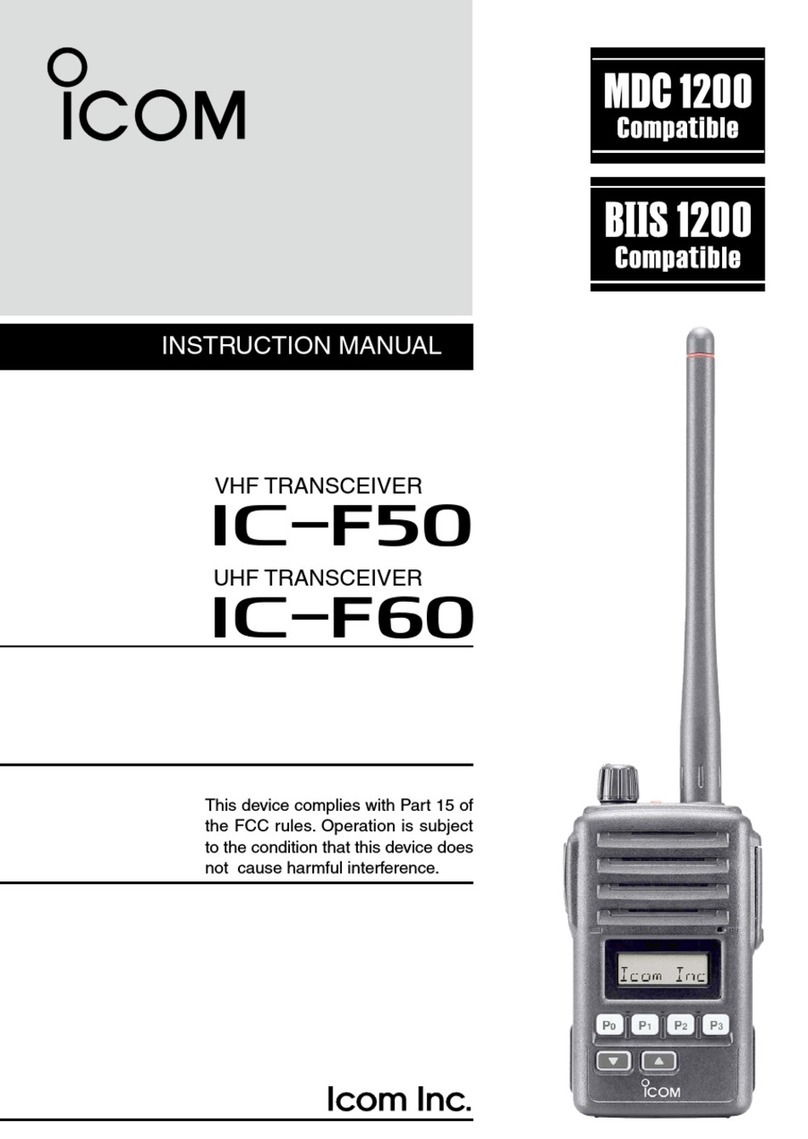
Icom
Icom VHF IC-F50 User manual

Icom
Icom IC-M7 User manual
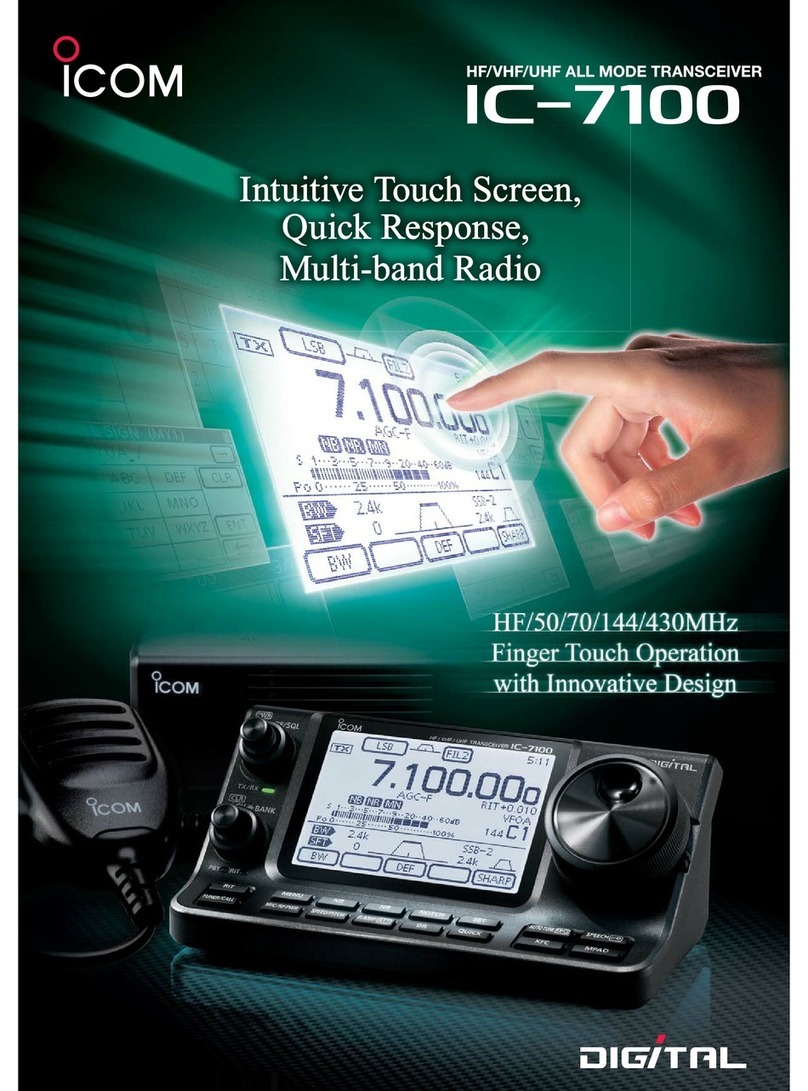
Icom
Icom IC-7100 User manual
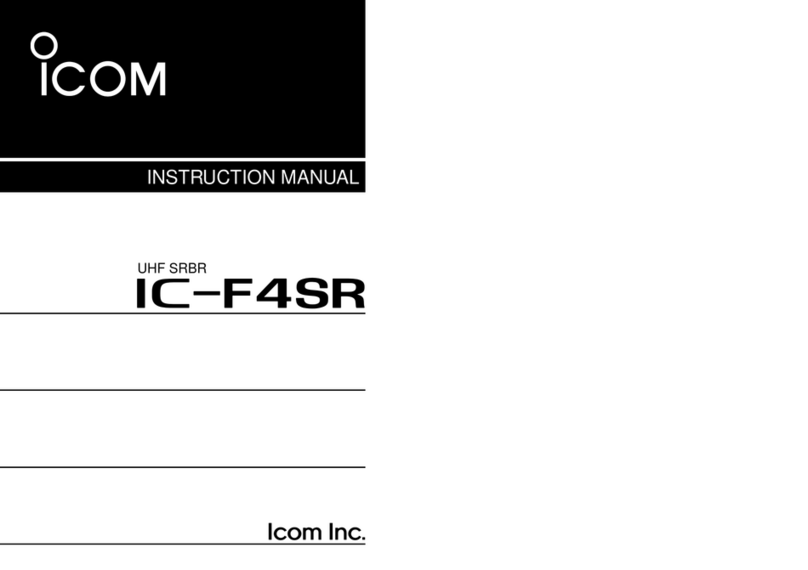
Icom
Icom IC-F4SR User manual
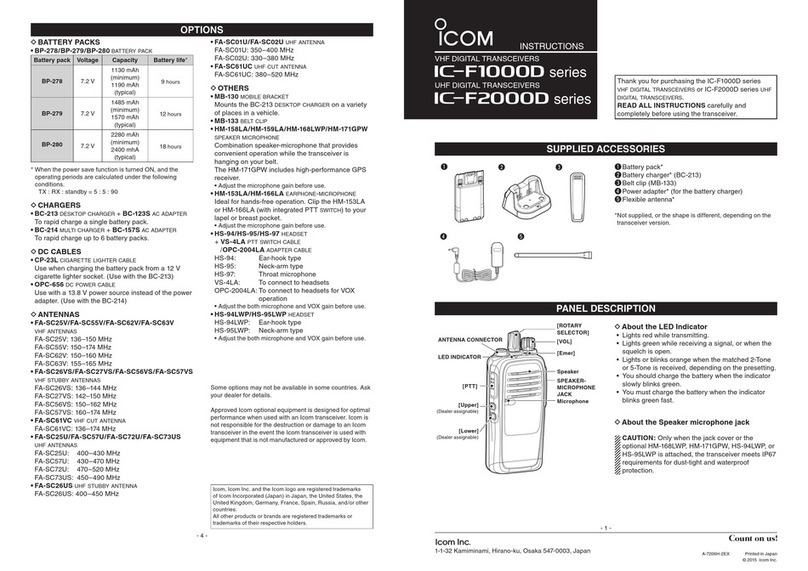
Icom
Icom ic-f1000d series User manual
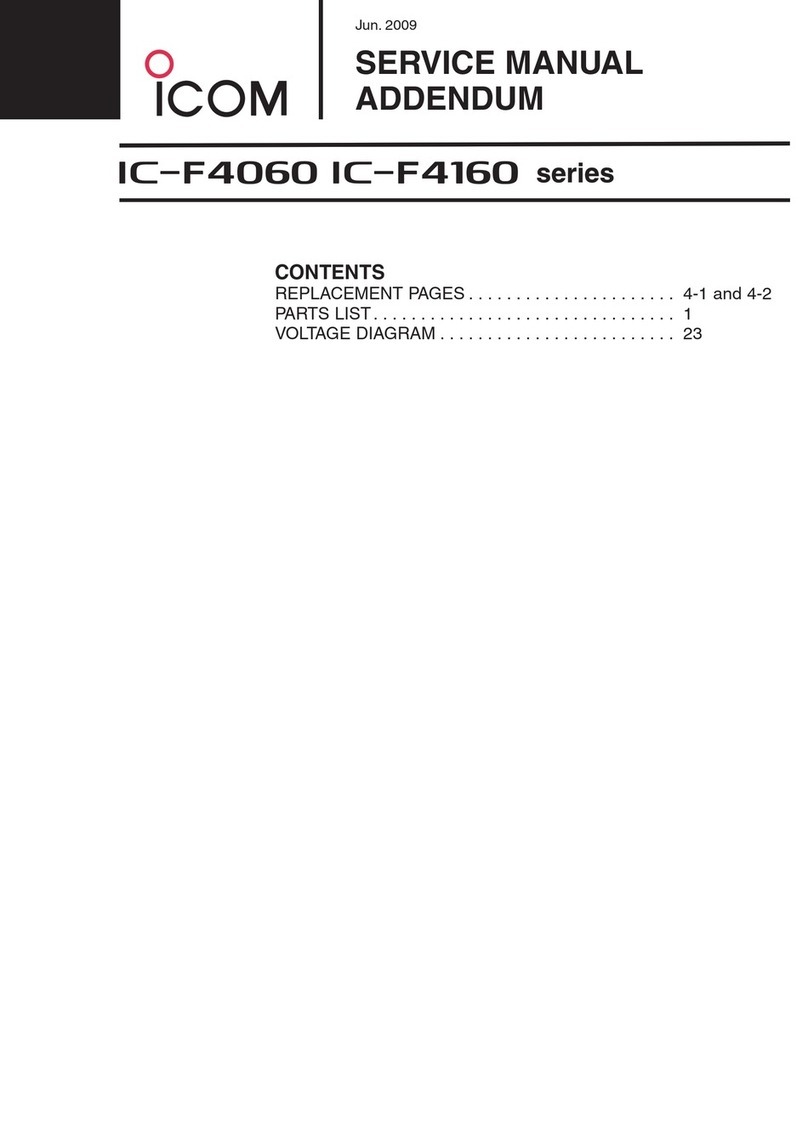
Icom
Icom IC-F4160 SERIES User manual
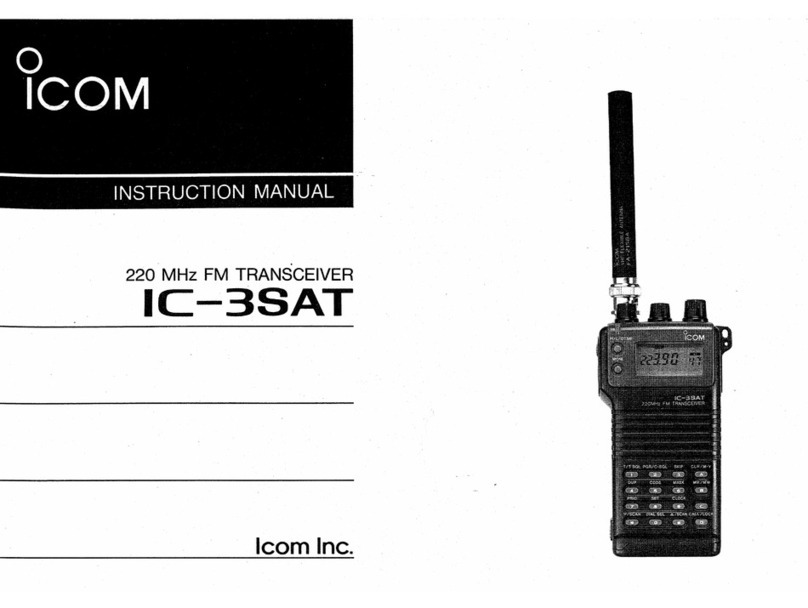
Icom
Icom IC-3SAT User manual
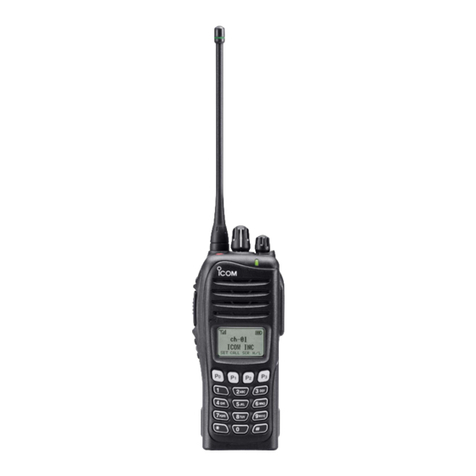
Icom
Icom IC-F3161 Series User manual
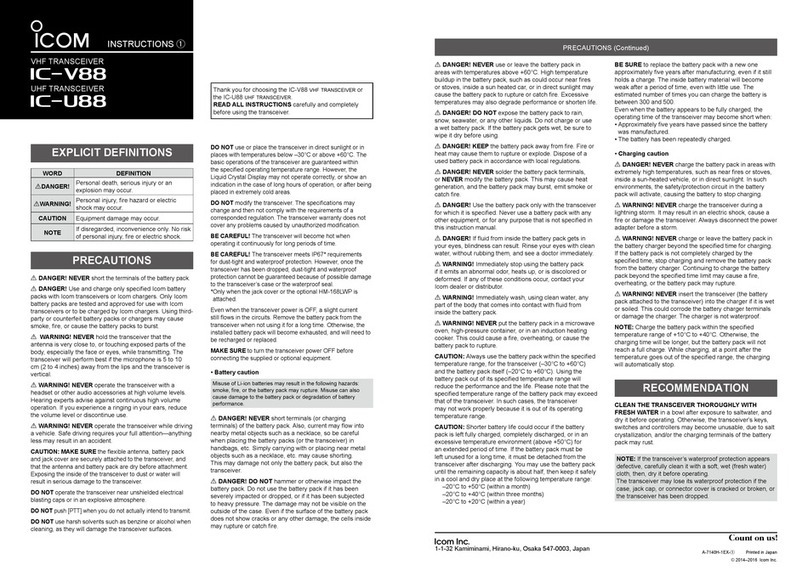
Icom
Icom Ic-V88 User manual

Icom
Icom IC-A25 Installation guide

Icom
Icom IC-761 User manual

Icom
Icom IC-F621 User manual
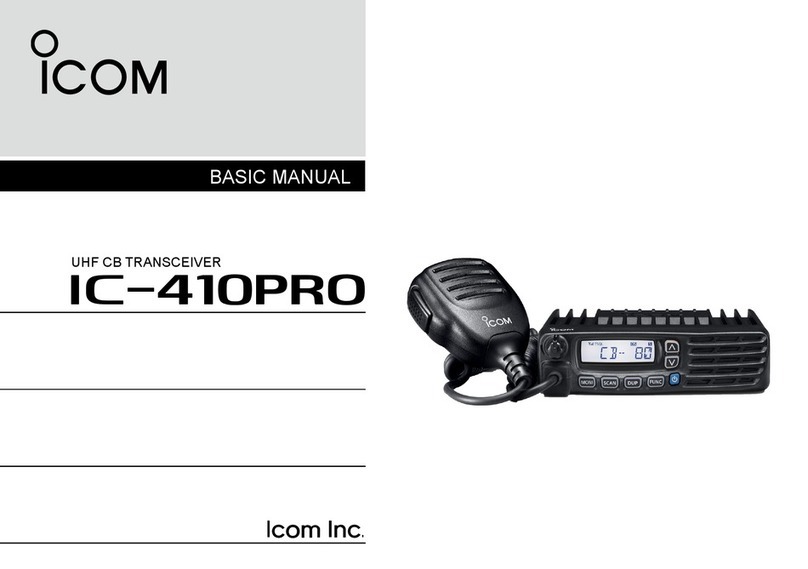
Icom
Icom IC-410PRO Installation guide
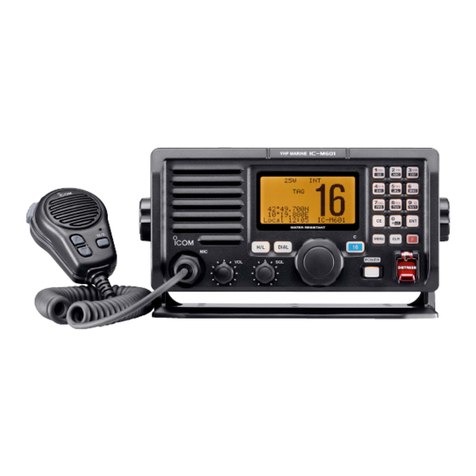
Icom
Icom IC-M601 User manual
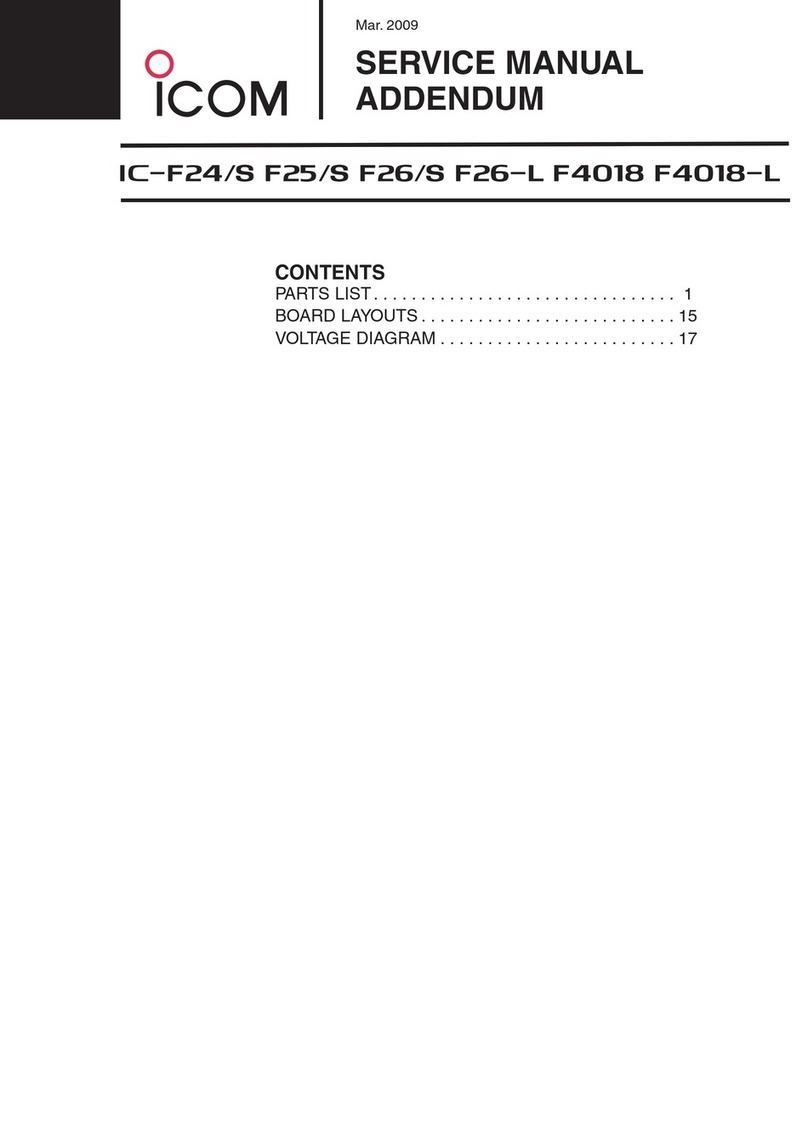
Icom
Icom IC-F24/S Installation and operating instructions
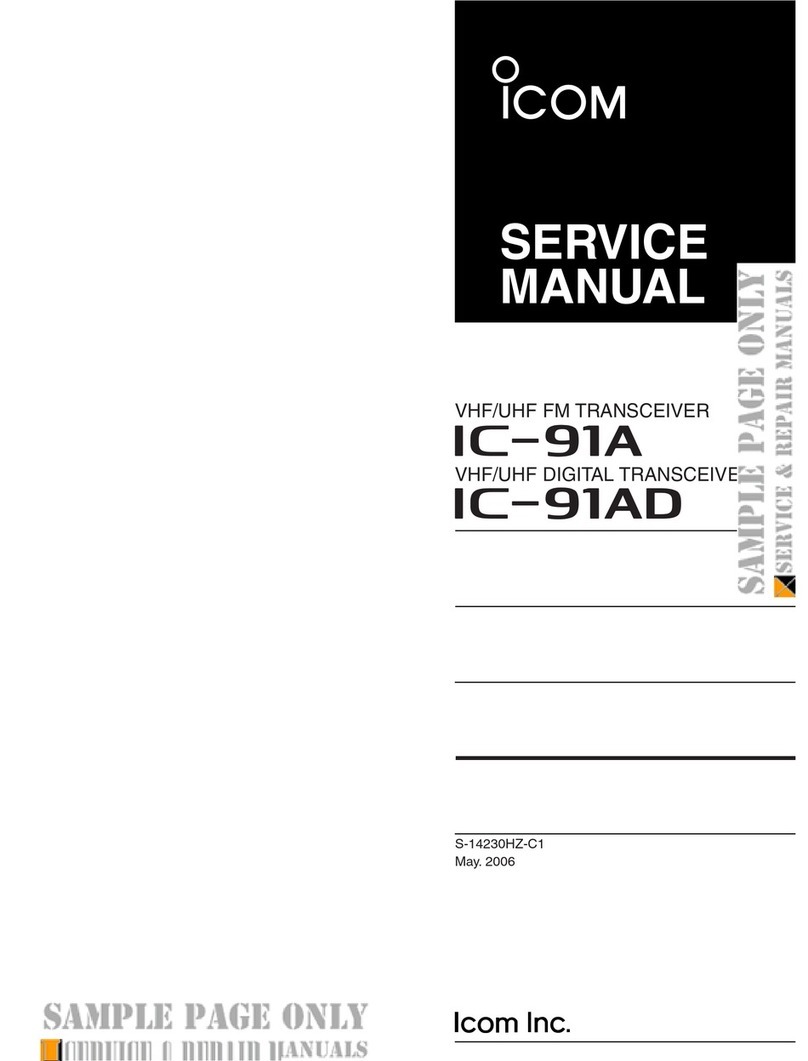
Icom
Icom IC-91A User manual

Icom
Icom IC-M59 User manual
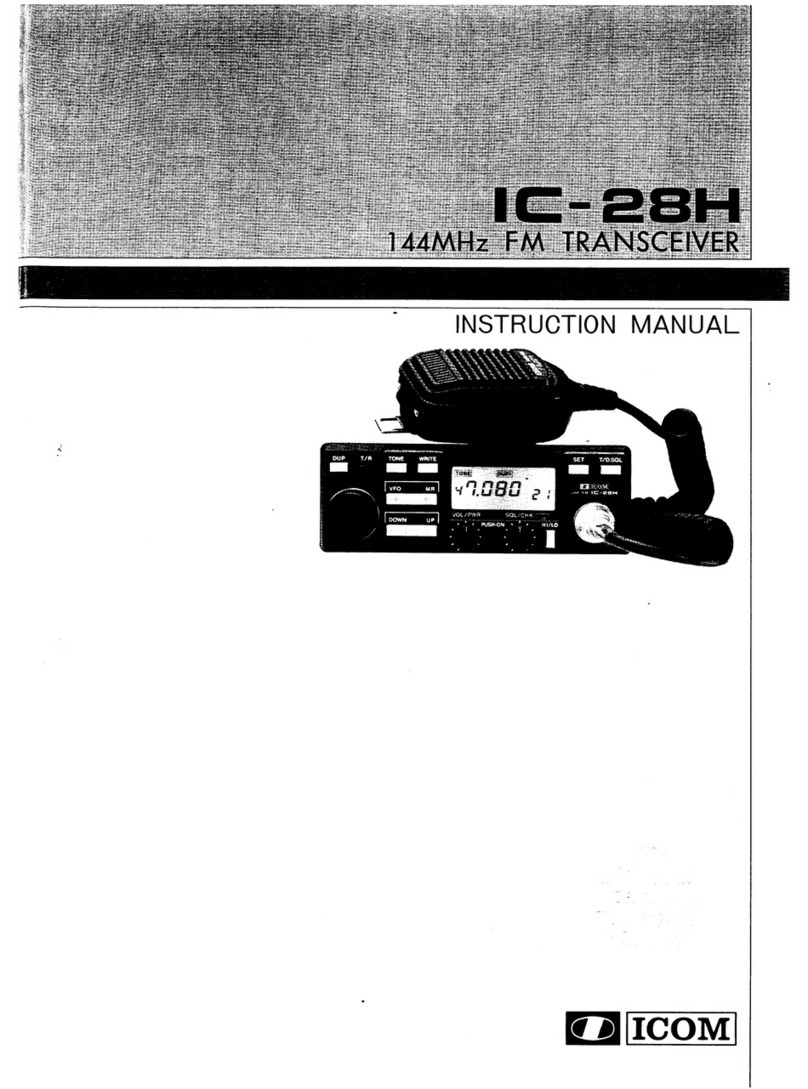
Icom
Icom IC-28H User manual

Icom
Icom IC-M56 User manual
